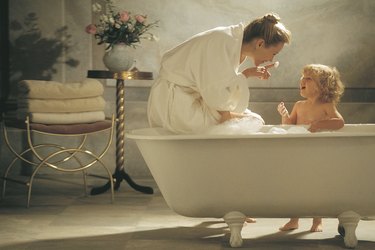
Nothing makes a bathroom look classier than a traditional porcelain enamel claw-foot tub, but looks aren't everything. While attractive, porcelain tubs are not necessarily the best option for homeowners who want the most comfort, performance, durability and value from their bathtub. Modern acrylic tubs lack most of porcelain's drawbacks without adding many disadvantages of their own.
Porcelain-Coated Cast Iron
Video of the Day
Cast iron enameled with porcelain, a ceramic material made especially durable by firing it at a high temperature, has been used to make bathtubs since the 19th century. It is extremely durable, but it has many disadvantages. It is extremely heavy, and iron tubs are rarely available in the larger sizes that are popular in modern bathrooms. Its surface is cold to the touch, and the porcelain coating is prone to chipping and cracking, which is difficult to repair.
Video of the Day
Porcelain-Coated Steel
Steel tubs coated with porcelain emulate the look of cast iron tubs while improving upon some of iron's shortcomings. Steel is considerably lighter than iron, and steel tubs are less expensive than iron tubs. However, the porcelain enamel on a steel tub is as vulnerable to chipping as that on an iron tub, and the surface has the same cool feel. In addition, steel tubs tend to be noisy when they are being filled with water.
Acrylic Tubs
Acrylic tubs have several advantages over porcelain enamel tubs, either steel or cast iron. Acrylic tubs are lightweight and durable. They are substantially less expensive than porcelain tubs, and they are available in a wider variety of styles and colors. Acrylic surfaces are less resistant to scratches than porcelain, and acrylic can be repaired much more easily than porcelain. Acrylic is warmer to the touch than porcelain, and acrylic tubs retain the heat of the bath water in them longer than iron or steel tubs do.
Acrylic Tub Surrounds
Iron and steel tubs must be surrounded by a water-resistant wall, usually consisting of ceramic tile, making installation of these tubs costly, time consuming and labor intensive. Acrylic tub surrounds use walls made of acrylic sheets to enclose the tub; these sheets are easier to install and less expensive than tile walls. This advantage is shared by fiberglass tub surrounds, but acrylic is more durable than fiberglass.